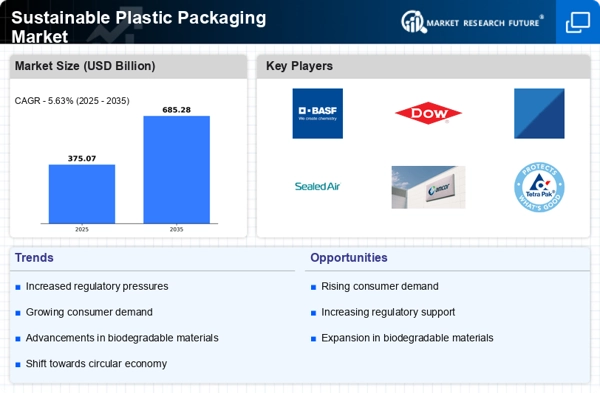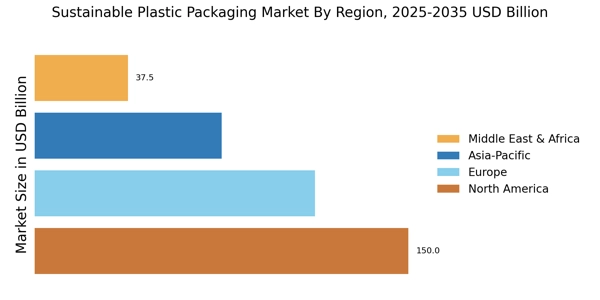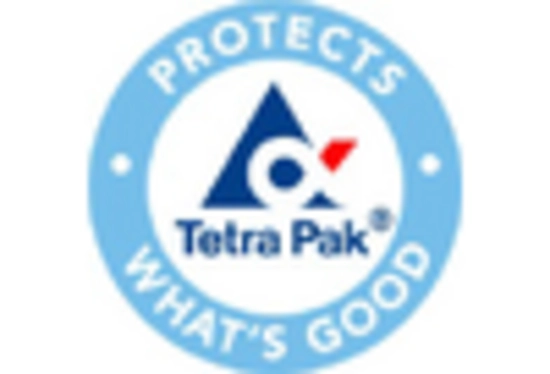Corporate Sustainability Initiatives
Many corporations are adopting sustainability initiatives as part of their broader corporate social responsibility strategies, which is positively impacting the Sustainable Plastic Packaging Market. Companies are recognizing that sustainable packaging not only enhances their brand image but also meets the growing consumer demand for environmentally responsible products. This trend is evident in various sectors, including food and beverage, where brands are transitioning to sustainable packaging solutions. The commitment to sustainability is likely to foster collaboration between businesses and suppliers, leading to innovative solutions within the Sustainable Plastic Packaging Market. As more companies set ambitious sustainability goals, the market is expected to expand further.
Investment in Recycling Infrastructure
Investment in recycling infrastructure is crucial for the growth of the Sustainable Plastic Packaging Market. Enhanced recycling capabilities can significantly reduce the environmental impact of plastic waste, making sustainable packaging solutions more viable. Governments and private entities are increasingly funding initiatives aimed at improving recycling rates and developing advanced recycling technologies. This investment not only supports the circular economy but also encourages manufacturers to utilize recycled materials in their packaging. As recycling becomes more efficient and widespread, the Sustainable Plastic Packaging Market is likely to benefit from a greater supply of sustainable materials, thereby driving further innovation and adoption.
Growing Consumer Awareness and Preferences
Consumer awareness regarding environmental issues is significantly influencing the Sustainable Plastic Packaging Market. As individuals become more informed about the detrimental effects of plastic pollution, there is a marked shift in purchasing behavior towards products that utilize sustainable packaging. Surveys indicate that a substantial percentage of consumers are willing to pay a premium for eco-friendly packaging solutions. This shift in consumer preferences is prompting manufacturers to adopt sustainable practices, thereby driving growth in the Sustainable Plastic Packaging Market. The increasing demand for transparency in sourcing and production processes further underscores the importance of sustainability in packaging.
Regulatory Support for Sustainable Practices
The Sustainable Plastic Packaging Market is experiencing a surge in regulatory support aimed at promoting environmentally friendly practices. Governments are increasingly implementing stringent regulations to reduce plastic waste and encourage the use of sustainable materials. For instance, policies that mandate the reduction of single-use plastics are becoming more prevalent. This regulatory landscape is likely to drive innovation within the Sustainable Plastic Packaging Market, as companies seek to comply with these regulations while also appealing to environmentally conscious consumers. The market is projected to grow significantly, with estimates suggesting a compound annual growth rate of over 10% in the coming years, driven by these supportive policies.
Technological Advancements in Material Science
Technological advancements in material science are playing a pivotal role in the Sustainable Plastic Packaging Market. Innovations in biodegradable and compostable materials are emerging, providing alternatives to traditional plastics. These advancements not only enhance the performance of sustainable packaging but also address consumer concerns regarding environmental impact. The development of new polymers that decompose more efficiently is indicative of a broader trend towards sustainability. As companies invest in research and development, the Sustainable Plastic Packaging Market is likely to witness a diversification of product offerings, catering to a wider range of consumer preferences and regulatory requirements.


















Leave a Comment